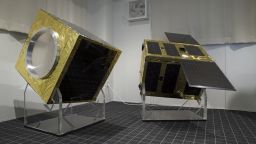Editor’s Note: This feature is part of Vision Japan, a series about the visionaries who are changing Japan, and the places that inspire this innovation. See more here.
Story highlights
Japanese scientists are developing a system to capture and remove space debris
They plan to use magnets to catch and force debris down to burn up in Earth's atmosphere
Japan’s Space Sweepers are taking it upon themselves to do a little spring cleaning in space.
One hundred and seventy million pieces of space debris currently orbit the Earth, according to estimates from the European Space Agency (ESA). Defunct satellites and other man-made objects rocket around the atmosphere at eight kilometers per second – 10 times faster than a bullet.
Some chunks are as big as a truck, others smaller than a dime. But even the tiniest piece of cosmic junk poses an enormous threat to other satellites and spacecraft.
A collision with a one centimeter speck of space debris at orbital velocity, for example, has the equivalent energy force of an exploding hand grenade, according to Heiner Klinkrad, head of the space debris office at the ESA.
When an accident like this occurs, fragments scatter around space, increasing the risk of further accidents.
That’s where the Space Sweepers come in.
Singapore-based satellite services company Astroscale has recruited a team of specialist “Space Sweepers” to develop key technologies to destroy space debris by forcing it down into the atmosphere where it will burn up upon re-entry.
In 2016 the company secured $35 million in venture funding, the bulk of which came from Innovation Network Corporation of Japan.
“From the construction to the successful launch, it is an extremely challenging mission,” President of Astroscale Miki Ito tells CNN.
How to destroy debris
From its manufacturing plant in Tokyo, Astroscale is currently developing two types of satellite.
One is a micro satellite that will collect real-time data on space junk that’s smaller than a millimeter. The data will be used to develop an up-to-date orbital debris map, which could then be sold to academics, international agencies and corporate satellite operators.

The other – called End-of-Life Service by Astroscale (ELSA) – will capture and remove defunct spacecraft belonging to satellite operators.
ELSA is currently in the design phase but Astroscale plans to use magnets and an undisclosed secondary method to catch satellites. Once captured, ELSA would force the debris down to the Earth’s atmosphere and both would burn up.
“We equip [ELSA] with cameras – sensors that can measure distances and things like that,” Ito explains. “By using these sensors and cameras, we determine the location of [the satellite], in order to make it easier to capture.”
Astroscale is planning a demonstration of ELSA for October 2019.
Both NASA and the ESA have long been studying technologies to approach, capture and safely de-orbit defunct objects. Proposed capture technologies include nets, robotic arms and harpoons.
Cleaning up space debris
Dodging debris Sandra Bullock style
Japan’s second female astronaut, Naoko Yamazaki experienced the risks of space debris first hand when she flew to the International Space Station (ISS) in 2010.
“During my mission we found a small crack on the window of the space shuttle,” she tells CNN. “We took a photograph and sent it to the ground so that they could check if it’s OK for the re-entry.”
Fortunately, the crack – which was smaller than an inch – was non-threatening, but bigger debris could be catastrophic. So much so that the ISS has a “Debris Avoidance Maneuver” to slightly alter the Station’s orbit and evade a possible collision with another object.
“We fire some thrust and then it [the ISS] can change the altitude or it can change its orientation,” explains Yamazaki.
This is only possible if the object is bigger than 10 centimeters and can be detected from Earth. If there is no time to move the Station out of the danger zone, the crew will escape – much like George Clooney and Sandra Bullock in sci-fi thriller “Gravity” – to the Soyuz spacecraft.
How it affects earthlings
Space debris is not only a threat for manned space flights, but also for the satellites impacting our daily lives.
“The satellites have essential roles … like weather forecasts, communications and GPS,” explains Yamazaki.
Astroscale plans to sell its satellite-removing services to companies with large satellite networks.
While there is no law saying owners must remove defunct satellites, the Inter-Agency Space Debris Coordination Committee has general guidelines that state satellites and spacecraft should be returned to Earth’s atmosphere within 25 years of their operational lifetime.
“We are trying out the technology that has never been demonstrated before – in such a short period of time,” Ito says.
“If we don’t try to contribute to making the outer space cleaner, it could be a threat to our lives.”























